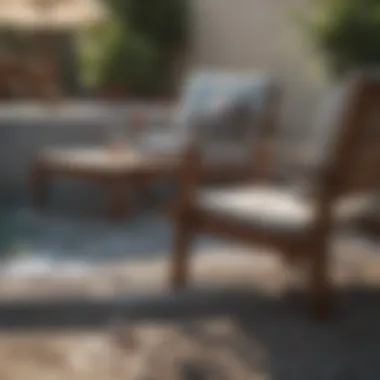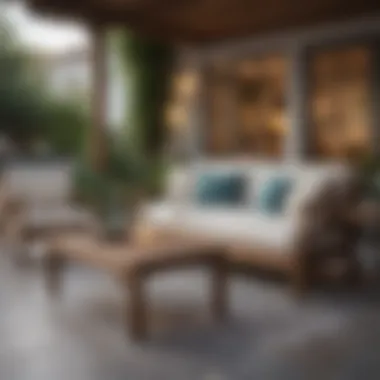Best Outdoor Furniture for Coastal Living


Intro
Selecting outdoor furniture for coastal environments poses unique challenges. Salt water, humidity, and strong winds can significantly affect the durability and aesthetics of furniture. Understanding these specific conditions is essential for homeowners and enthusiasts looking to create inviting outdoor spaces that withstand the test of time.
This article explores essential materials, design elements, and maintenance practices tailored for those living near salt water. Readers will also find product recommendations that emphasize both functionality and visual appeal, ensuring a rewarding outdoor experience.
Design Inspiration
Current Trends in Outdoor Design
In coastal areas, outdoor furniture trends reflect both functionality and style. Minimalism is gaining traction. Simple lines and natural materials dominate the landscape. Furniture made from teak and aluminum often stands out, providing both elegance and resilience against salty air. The trend leans towards sustainable materials, focusing on long-lasting quality that doesn’t compromise the environment.
Accessories such as cushions and lanterns complement outdoor spaces, often featuring bold color contrasts. This approach creates a vibrant atmosphere, heightened by the natural beauty of the seaside.
Color Schemes and Palette Ideas
Color choices play a critical role in outdoor design, especially in coastal environments. Shades of blue and green mirror the nearby ocean, creating a harmonious connection. Beige and white offer a clean look, often augmented with darker accents.
- Color Palette Ideas
- Ocean Blues: Light navy, turquoise, and teal
- Earthy Tones: Sandy beige, soft greens, and warm browns
- Bright Accents: Coral pink, sun-kissed yellows, and vibrant reds
The right colors can evoke a sense of calm and relaxation, inviting gatherings and outdoor activities. Choosing durable fabrics that resist fading adds another layer of consideration.
"Durable materials and cohesive color schemes foster inviting spaces that enhance outdoor living experiences."
In this guide, we will explore specific materials suited for coastal environments, delve into maintenance tips, and offer product recommendations that align with the trends mentioned above. By understanding and applying these principles, homeowners can create spaces that not only look good but also endure the coastal elements.
Understanding Coastal Environments
Coastal environments present unique challenges and opportunities in terms of outdoor furniture selection. For homeowners and design enthusiasts living near salt water, understanding these environments is not just beneficial; it is essential. Salt air, humidity, and varying weather conditions mean not all furniture materials will hold up over time. Therefore, choosing the right outdoor furniture is paramount to enhancing both the aesthetic and functionality of these spaces.
By understanding coastal environments, one can appreciate how certain materials perform under harsh conditions. Outdoor gatherings, leisure activities, or simply enjoying the beauty of nature are all enhanced with the practical and elegant choices in furniture. If you invest in suitable options, they offer value longevity and visual appeal.
Characteristics of Salt Water Areas
Salt water regions have specific characteristics. The air often contains higher concentrations of salt, coupled with significant humidity levels. These factors contribute to the unique ecosystems found near the ocean but also indicate potential risks for outdoor furniture. The corrosive properties of salt can accelerate wear and tear on surfaces that might otherwise be resilient in different climates.
In addition to saltiness and humidity, coastal areas frequently face strong winds. These winds can affect the stability of lighter furniture pieces, making it essential to consider weight and anchoring during product selection. Often, furniture may require extra care and consideration to prevent damage.
Effects of Salt and Humidity on Furniture


The effects of salt and humidity on outdoor furniture are profound and require attention. Salt can lead to rust, corrosion, and deterioration of various materials. For instance, untreated wood may suffer from warping or rotting, while metals may begin to show signs of rust sooner than expected.
Humidity exacerbates these effects. It can promote mold and mildew growth on fabrics and wood, leading to unpleasant odors and the need for constant upkeep. Therefore, selecting furniture specifically designed to withstand these elements becomes crucial.
To combat these challenges, consider the following strategies when choosing outdoor furniture:
- Opt for materials that are resistant to corrosion, such as stainless steel or treated wood.
- Regular maintenance and cleaning can significantly extend the life of your furniture.
- Protective treatments or coatings can provide a barrier against moisture and salt damage.
"Investing in high-quality outdoor furniture near coastal environments can save money and time in the long run."
Materials Suitable for Outdoor Furniture
Selecting the right materials for outdoor furniture is critical, particularly in coastal regions where salt water and humidity can wreak havoc on less durable options. These materials not only determine the longevity of the furniture but also its performance in a challenging environment. The ideal materials should offer resilience against corrosion and decay, while also enhancing the aesthetic appeal of outdoor spaces.
In this section, we focus on an array of materials—each with distinct characteristics and benefits. Understanding these factors will help homeowners and design enthusiasts make informed choices tailored to their outdoor settings.
Teak: The Classic Choice
Teak has long been recognized as a premier material for outdoor furniture. Its natural oils provide a robust defense against moisture and salt, making it less susceptible to warping and cracking. Teak also develops a beautiful silvery patina over time, allowing it to age gracefully. Homeowners appreciate its warm tones and durability, making it a favorite for coastal settings. Proper care, such as regular oiling, can prolong its life even further, maintaining its rich color and finish.
Aluminum: Lightweight and Durable
Aluminum emerges as another strong candidate for outdoor furniture. It is remarkably lightweight, making it easy to move and rearrange. Despite its lightweight nature, it boasts impressive durability. Aluminum does not rust, which is a crucial feature near salt water. Many manufacturers apply powder coatings to enhance its weather resistance, ensuring it maintains its appearance year after year. Its modern aesthetic caters well to contemporary outdoor designs.
Wicker: A Blended Material Option
Wicker furniture can offer a blend of comfort and style. This material typically includes natural or synthetic fibers woven around a frame. For coastal environments, synthetic wicker often proves to be the most suitable option due to its resistance to moisture and fading. It requires less maintenance than natural wicker and is less prone to damage.
Natural Wicker vs. Synthetic Wicker
The comparison of natural wicker and synthetic wicker is essential in determining the best choice for your outdoor space. Natural wicker, made from materials like rattan or reed, retains a traditional charm. However, it can absorb moisture, making it less suitable for coastal areas. This absorption might lead to mold growth and deterioration over time.
On the other hand, synthetic wicker is designed to replicate the appearance of natural materials while providing superior durability. It is resistant to the elements and is relatively easy to clean. Homeowners often prefer synthetic wicker for its functionality coupled with a diverse range of designs.
Stainless Steel: Modern Aesthetic
Stainless steel furniture brings a sleek, modern look to outdoor spaces. Its non-corrosive properties make it a solid choice for coastal environments. Stainless steel can withstand harsh weather conditions, and its maintenance is minimal, requiring only occasional cleaning to remove salt residue. The combination of stainless steel with other materials can add style and functionality to any outdoor area, proving to be both durable and visually appealing.
Design Considerations for Outdoor Furniture
In the selection of outdoor furniture, especially in regions affected by salty coastal air, design considerations are crucial. The outdoor space should reflect personal style while ensuring robustness against environmental challenges. Observing how designs interact with functionality, comfort, and aesthetics can make a significant difference in the longevity and enjoyment of your outdoor area.


When contemplating outdoor furniture, it is essential to remember that it must coexist with its environment, while also meeting the practical needs of everyday use. Well-thought-out designs not only enhance visual appeal but also contribute to a more functional outdoor experience.
Style and Aesthetic Compatibility
Creating a harmonious look for your outdoor setting begins with style and aesthetic compatibility. This factor includes how the furniture integrates with existing architecture and landscaping. Furniture should complement both the home’s exterior and the natural surroundings.
Considerations for selecting a compatible style:
- Theme Matching: Whether it's a modern, rustic, or coastal theme, the chosen outdoor furniture should align with your chosen aesthetic.
- Color Coordination: Selecting colors that work both with your home and with the outdoor environment enhances the visual appeal. Neutral colors usually work well as they are less likely to clash with vibrant outdoor elements.
- Material Consistency: If your home features wood, consider wooden furniture. For contemporary homes, aluminum or stainless steel options may offer a sleeker look.
These choices not only enhance the beauty of your space but also provide a lasting impression.
Comfort and Functionality
An outdoor space is only enjoyable if the furniture provides adequate comfort and practicality. Comfort often overlaps with functionality, as items that are easy to use increase the likelihood of being enjoyed.
Key points to consider in comfort and functionality:
- Ergonomics: Ensure that seating provides adequate support. Chairs with well-designed backrests and armrests enhance the user experience.
- Versatility: Choose furniture that can adapt to various occasions. Folding tables, stackable chairs, or modular sets can be ideal for entertaining or for small space usage.
- Ease of Maintenance: Being near saltwater can lead to wear and tear. Select furniture that is easy to clean and care for. Some materials require more upkeep than others.
In summary, prioritizing these design considerations ensures that your outdoor setup is not only visually appealing but also functional and comfortable. The right choice will enhance outdoor living experiences and promote a serene space that invites relaxation and social gatherings.
Maintenance of Outdoor Furniture Near Salt Water
Maintaining outdoor furniture in coastal environments is critical. Salt and humidity can significantly degrade materials over time. Proper maintenance helps to extend the life of your furniture, ensuring it remains functional and attractive. Neglect can lead to corrosion, fading, and structural damage, ultimately requiring costly replacements. Knowing how to care for your outdoor investments is essential, especially for homeowners in salt water areas.
Cleaning and Protective Treatments
Regular cleaning is paramount for outdoor furniture. Salt residue can accumulate and attract moisture, both of which are damaging. Depending on the material, the cleaning method will vary.
- For teak furniture, simply wash with warm water and mild soap. Avoid harsh chemicals, as they may strip the natural oils.
- Aluminum can be treated with a mixture of vinegar and water. This approach removes salt build-up without damaging the surface. You can also apply a protective wax to enhance its shine and prevent oxidation.
- For wicker, regular vacuuming and a soft brush can remove dirt. Use a sponge and soap solution to clean but allow it to dry completely to avoid mold.
- Stainless steel will benefit from a gentle cleaner made specifically for metal surfaces. This can help maintain its original aesthetics.
After cleaning, applying protective treatments is advisable. Using a sealant can create a barrier against salt and humidity. This not only keeps furniture looking new but also prevents corrosion.
Seasonal Care Tips
As seasons change, so do maintenance needs. Here are some seasonal tips to care for your outdoor furniture:
- Spring: Inspect for winter damage. Clean thoroughly and apply any necessary treatments.
- Summer: Regularly hose down furniture to remove salt and debris. If furniture is used frequently, consider using furniture covers to protect them when not in use.
- Fall: Clean furniture again to prepare for winter. Store accessories indoors to prevent winter weather damage.
- Winter: If you live in a particularly harsh climate, store your furniture indoors. For those who prefer leaving it outside, ensure it is well-covered with weather-resistant materials.
"Regular maintenance not only prolongs the life of your furniture but also enhances the enjoyment of your outdoor space."


By following these cleaning methods and seasonal care tips, homeowners can maintain their outdoor investments effectively and enjoy their spaces without concern for deterioration.
Top Recommendations for Outdoor Furniture
Selecting the right outdoor furniture is critical for enhancing your coastal living spaces. The furniture must withstand the rigors of salt water environments, which means longevity and durability are paramount. Reviews suggest that the wrong choice can lead to quick degradation of materials, prompting replacements sooner than anticipated. Therefore, understanding the facts behind various furniture options is key. The recommendations below are based on material performance, design compatibility, and aesthetic appeal.
Best Teak Furniture Brands
Teak wood has been esteemed for generations due to its natural oils that resist moisture and pests. Its rich golden hue also adds elegance to outdoor spaces, making it a favored choice. Brands like Kingsley Bate and Tropitone have paired excellent craftsmanship with quality teak resources. These manufacturers focus on sustainable harvesting, ensuring their wood comes from responsibly managed forests.
Investing in pieces from these brands means you are buying furniture designed to last against the harsh elements of coastal climates. Additionally, teak furniture often weathers beautifully, developing a silver-gray patina over time if left untreated, which many find appealing.
Durable Aluminum Options
Aluminum furniture is another outstanding choice for coastal environments. Its lightweight nature makes it easy to rearrange, but more importantly, aluminum resists corrosion. Brands like Polywood and Cabanacoast offer aluminum furniture that combines functionality with design. Their powder-coated finishes provide an extra layer of protection against the salty air, preserving both color and structural integrity.
This type of furniture requires minimal maintenance, translating to a practical option for homeowners who value their time. Versatility in design ensures you can find pieces that complement diverse styles from modern to coastal chic.
Quality Synthetic Wicker Collections
Synthetic wicker has gained popularity, especially for outdoor settings. Unlike natural wicker, synthetic variants do not absorb moisture, making them more fitting for salt water zones. Companies like Crosley Furniture and Lloyd Flanders excel in this area, offering durable options that do not compromise on aesthetics. When choosing synthetic wicker, look for high-quality polyethylene or resin options that replicate the look of traditional wicker while providing enhanced durability.
The key differences between natural and synthetic wicker lie in their longevity and maintenance requirements. Natural wicker can rot and degrade in wet conditions, whereas synthetic wicker can endure much longer while requiring minimal care.
Stylish Stainless Steel Furniture
For a modern and clean look, stainless steel furniture is hard to beat. Brands like Gloster and Kettler produce pieces that blend strength with a sleek appeal. Stainless steel is resistant to rust and corrosion, especially when combined with high-grade cushions and coatings. It adds an element of sophistication to outdoor settings.
However, it is crucial to ensure that the stainless steel used is anti-corrosive, especially in salt water environments. A thorough research on songs related to the type of stainless steel is necessary to prevent future disappointments.
"Choosing outdoor furniture is not just about style, but it’s about investment in quality that can withstand the environment."
Finale: Making Informed Choices
Making informed choices about outdoor furniture, especially in coastal areas, is vital for homeowners looking to maintain both aesthetics and functionality in their outdoor living spaces. The interplay between the materials selected and the harsh conditions of salt water environments can significantly affect the longevity and appearance of furniture. As you navigate through various options, it is crucial to prioritize durability while ensuring the design complements your existing outdoor decor.
By doing this, you can create spaces that are not only visually appealing but also capable of enduring the salt and humidity challenging the integrity of furniture materials. Well-chosen outdoor furniture can enhance the experience of outdoor living, whether you are entertaining guests, enjoying family gatherings, or simply relaxing.
Balancing Aesthetics with Durability
When it comes to outdoor furniture, balancing aesthetics with durability is not just a preference; it is a must. Aesthetic appeal draws us to certain styles, colors, and materials that fit our taste. However, in a coastal setting, the right choice can withstand environmental stressors. Durable materials like teak, aluminum, and synthetic wicker offer exceptional resistance to corrosion and degradation caused by salty air.
- Teak is renowned for its rich color and natural oils, which enhance resistance to weather elements.
- Aluminum is lightweight yet sturdy, scaling well with varying styles, and available in various finishes.
- Synthetic wicker mimics natural rattan without the compromise of deterioration, offering a modern look.
It's a balancing act, ensuring that the pieces not only look good but will last for years despite the environmental challenges they face.
Final Thoughts on Outdoor Living Spaces
Creating an inviting outdoor living space is a fulfilling endeavor for any homeowner. This journey blends design, functionality, and practicality. With the right outdoor furniture, your space transforms into an oasis where memories are made. Consider your lifestyle; for instance, if you often host gatherings, you may want larger tables or versatile seating arrangements.



